Play Beach Pickleball with Sandy Pickle!
On our first introduction to pickleball, we were hooked. The only complaint was that our local courts were too crowded, so we bought a portable pickleball set with the intention of playing in the office parking lot. As we set it up for the first time, we wondered out loud what it would be like to play pickleball on the grass or at the beach. As we sought to find out, the game now known as “Sandy Pickle” was born!
The two biggest issues we faced as we began our test were, 1) A pickleball doesn’t bounce on grass or sand, and 2) Without a bounce, kill shots were too easy on a 3 foot net. We began modifying the court size, net height and official pickleball rules, and before long we had created a version of pickleball that was fun to play on ANY surface.
Sandy Pickle takes Pickleball to the Beach!
Now you can play pickleball on sand or grass; at the beach, in the park, or in your yard! Read below for a rules comparison between pickleball and Sandy Pickle.
1. Smaller Court Dimensions:
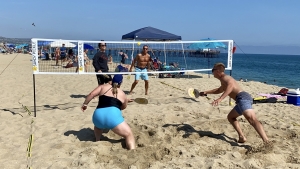
Besides the fact that players can’t move as fast on grass or sand as on a hard court, with no bounces every shot is a volley.
After hours of testing court coverage ability for players of all skill levels, the appropriate adjustments were made to the Sandy Pickle boundaries. Also, unlike pickleball where singles and doubles use the same boundaries, the Sandy Pickle singles court is smaller.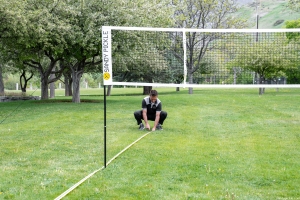
The singles* court width is 13′ 6″ (4.1 meters), and doubles is 16′ 8″ (5.1 meters), with baselines at 16′ for singles and 18′ for doubles.
*SandyPickle’s proprietary net design allows for easy width adjustment between singles & doubles.
2. Adjustable Net Height
As noted in #1, every shot in Sandy Pickle must be returned without a bounce. Our first discovery as we began testing at the standard pickleball net height was that kill shots were far too easy and the net needed to be raised.
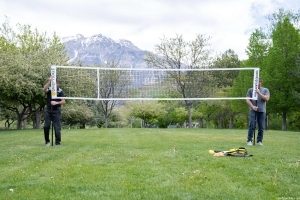
As we invited players of various heights to play our evolving Sandy Pickle game, we determined that the net should be set to the approximate height of the tallest player on the court, thus minimizing the spiking advantage of taller players. Our patent pending telescoping net system was designed to allow for easy height adjustments.
*For tournament play, the default height is 6’ but may be modified to accommodate for optional height and/or skill divisions.
3. No-Spike Zone
The area within 5’ of the net on each side is called the “No Spike Zone” (similar to the “Kitchen” in pickleball).
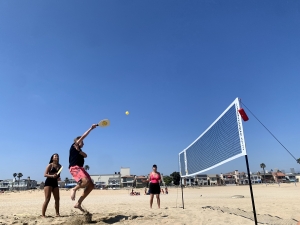 On each serve, the return must be made from behind the no spike zone line*; At all other times, the only restriction to playing inside this area is that spiking is not allowed inside the boundary. When playing inside this area, the trajectory of the ball must either be upward or flat; a downward ball path results is a fault.
On each serve, the return must be made from behind the no spike zone line*; At all other times, the only restriction to playing inside this area is that spiking is not allowed inside the boundary. When playing inside this area, the trajectory of the ball must either be upward or flat; a downward ball path results is a fault.
*Note, the no spike zone extends upward from the line, meaning that a ball hit with a downward trajectory must leave the paddle behind this imaginary plane.
4. One Pass, or “BUMP”
Did we mention that pickleballs don’t bounce well on sand or grass? During the later stages of testing, we realized that in the fast-paced exchange of shots, there were plenty of mis-hits that stayed in the air long enough for a teammate to send the ball back over the net. The suggestion was made that we try allowing a pass, whether or not the second shot opportunity was intentional.
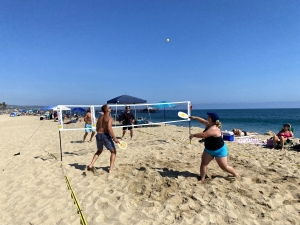 The addition of the 1-pass rule is now an official part of the game, however, it applies only in doubles play. The resulting longer, volley-only rallies make this already fast-paced game almost as fun to watch as it is to play!
The addition of the 1-pass rule is now an official part of the game, however, it applies only in doubles play. The resulting longer, volley-only rallies make this already fast-paced game almost as fun to watch as it is to play!
5. Serving
Serves are made from behind the baseline on the right hand side of the court (similar to volleyball) with no limitations as to which side of the court the serve is hit to. The non-serving partner plays the left (“backhand”) side of the court; teammates switch positions when the serve returns to their side after winning a defensive side-out. The player serving continues until they lose a point, after which the opposing team takes over the serve (in Sandy Pickle the serve alternates sides at the end of each players serving opportunity, unlike pickleball in which both teammates serve before a side-out).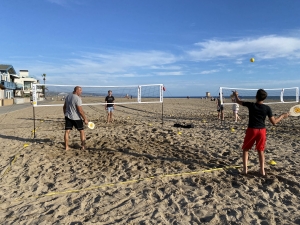
Also unlike pickleball, players may serve overhead, underhand, backhand, sidearm or otherwise so long as they serve from behind the baseline and the ball makes it over the net, beyond the no-spike zone, and within the boundaries. A serve is “out” if it lands within the no-spike zone or outside court boundaries. If the ball hits the net but lands within the boundaries, it is considered “in” (similar to pickleball).
6. Scoring
Like pickleball, games are played to 11 points and must be won by 2 (or more). A point is earned when the player or team serving wins the point. If the player or team RECEIVING the serve wins the point, they take over the serve.
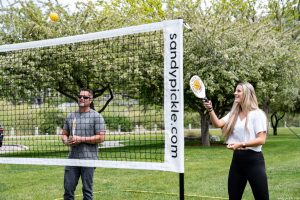 Scoring Note: When a team is winning 7-6, for example, the player serving would call out “7-6” rather than “7-6-1”. For experienced pickleball players, three-digit scoring calls are routine; for most of everyone else, the confusion warranted simplification in the official Sandy Pickle rules.
Scoring Note: When a team is winning 7-6, for example, the player serving would call out “7-6” rather than “7-6-1”. For experienced pickleball players, three-digit scoring calls are routine; for most of everyone else, the confusion warranted simplification in the official Sandy Pickle rules.


